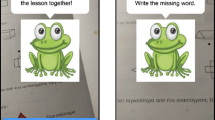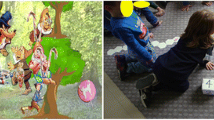Abstract
The purpose of this study is to investigate if and how information and communications technology (ICT) helps to improve first grade students’ basic geometry achievement regarding circles and triangles. Our research compares the level of geometrical competence of the students taught using our ICT oriented learning method specifically targeting “Realistic Mathematics Education” (RME) and the van Hiele model for geometry concepts, as opposed to “traditional” teaching methodology. The designed software consisted of a story and several activities with and without the use of computers for circles and triangles. The study involved first grade students in Crete and Athens, who were divided into two groups (experimental and control). The experimental group consisted of 113 students who were taught about circles and triangles with the support of computers. There were 121 students in the control group who were not exposed to the computer-oriented curriculum. Students in both groups were pretested and posttested for their geometry performance. The results of the study indicate that teaching and learning through ICT is an interactive process for students at the first grade level and has a positive effect for geometry learning using the background of RME and the van Hiele model.
Access this chapter
Tax calculation will be finalised at checkout
Purchases are for personal use only
Similar content being viewed by others
References
Bobis, J., Clarke, B., Clarke, D., Thomas, G., Wright, R., Gould, P., et al. (2005). Supporting teachers in the development of young children’s mathematical thinking: Three large scale cases. Mathematics Education Research Journal, 16(3), 27–57.
Burnett, C. (2009). Research into literacy and technology in primary classrooms: An exploration of understandings generated by recent studies. Journal of Research in Reading, 32(1), 22–37. doi:10.1111/j.1467-9817.2008.01379.x.
Chou, S.-W., & Liu, C.-H. (2005). Learning effectiveness in a Web-based virtual learning environment: a learner control perspective. Journal of Computer Assisted Learning, 21, 65–76.
Clements, D. H. (2002). Computers in early childhood mathematics. Contemporary Issues in Early Childhood, 3(2), 160–181.
Clements, D. H., & Battista, M. T. (1992). Geometry and spatial reasoning. In D. A. Grouws (Ed.), Handbook of research on mathematics teaching and learning (pp. 420–464). New York: Macmillan.
Clements, D. H., & Sarama, J. (2004). Building blocks for early childhood mathematics. Early Childhood Research Quarterly, 19, 181–189.
Clements, D. H., Swaminathan, S., Zeitler-Hannibal, M., & Sarama, J. (1999). Reviewed work(s). Journal for Research in Mathematics Education, 30(2), 192–212. National Council of Teachers of Mathematics Stable. http://www.jstor.org/stable/749610.
Dimakos, G., & Zaranis, N. (2010). The influence of the Geometer’s Sketchpad on the geometry achievement of Greek school students. The Teaching of Mathematics, 13(2), 113–124. Retrieved March 29, 2011, from http://elib.mi.sanu.ac.rs/files/journals/tm/25/tm1324.pdf.
Dissanayake, S. N., Karunananda, A. S., & Lekamge, G. D. (2007). Use of computer technology for the teaching of primary school mathematics. OUSL Journal, 4, 33–52.
Druin, A., & Fast, K. (2002). The child as learner, critic, inventor, and technology design partner: An analysis of three years of Swedish student journals. The International Journal for Technology and Design Education, 12(3), 189–213.
Dwyer, J. (2007). Computer-based Learning in a primary school: Differences between the early and later years of primary schooling. Asia-Pacific Journal of Teacher Education, 35(1), 89–103. doi:10.1080/13598660601111307.
Finegan, C., & Austin, J. (2002). Developmentally appropriate technology for young children. Information Technology in Childhood Education Annual, 1, 87–102.
Fisher, T., Denning, T., Higgins, C., & Loveless, A. (2012). Teachers’ knowing how to use technology: Exploring a conceptual framework for purposeful learning activity. Curriculum Journal, 23(3), 307–325. doi:10.1080/09585176.2012.703492.
Freudenthal, H. (1968). Why to teach mathematics so as to be useful? Educational Studies in Mathematics, 1, 3–8.
Furner, J. M., & Marinas, C. A. (2007). Geometry sketching software for elementary children: Easy as 1, 2, 3. Eurasia Journal of Mathematics, Science & Technology Education, 3(1), 83–91.
Gersten, R., Jordan, N., & Flojo, J. (2005). Early identification and interventions for students with mathematics difficulties. Journal of Learning Disabilities, 38(4), 293–304.
Hardman, J. (2005). An exploratory case study of computer use in a primary school mathematics classroom: New technology, new pedagogy? Perspectives in Education, 23(4), 99–111.
Howie, S., & Blignaut, A. S. (2009). South Africa’s readiness to integrate ICT into mathematics and science pedagogy in secondary schools. Education Information Technology, 14, 345–363. doi:10.1007/s10639-009-9105-0.
Keong, C. C., Horani, S., & Daniel, J. (2005). A study on the use of ICT in mathematics teaching. Malaysian Online Journal of Instructional Technology (MOJIT), 2(3), 43–51.
Lee, Y. (2009). Pre-K children’s interaction with educational software programs: An observation of capabilities and levels of engagement. Journal of Educational Multimedia and Hypermedia, 18(3), 289–309.
Livingstone, S. (2012). Critical reflections on the benefits of ICT in education. Oxford Review of Education, 38(1), 9–24. doi:10.1080/03054985.2011.577938.
Pallant, J. (2001). SPSS survival manual. Buckingham, UK: Open University Press.
Passey, D. (2006). Technology enhancing learning: Analysing uses of information and communication technologies by primary and secondary school pupils with learning frameworks. Curriculum Journal, 17(2), 139–166. doi:10.1080/09585170600792761.
Plowman, L., & Stephen, C. (2003). A “benign addition”? Research on ICT and pre-school children. Journal of Computer Assisted Learning, 19(2), 149–164.
Remtulla, K. A. (2010). “Media Mediators”: Advocating an alternate paradigm for critical adult education ICT policy. Journal for Critical Education Policy Studies, 7(3), 300–324.
Satlow, Ε., & Newcombe, Ν. (1998). When is a triangle not a triangle? Young children’s developing concepts of geometry shape. Cognitive Development, 13, 547–559. Ablex Publishing.
Sife, A. S., Lwoga, E. T., & Sanga, C. (2007). New technologies for teaching and learning: Challenges for higher learning institutions in developing countries. International Journal of Education and Development using Information and Communication Technology (IJEDICT), 3(2), 57–67.
Starkey, P., Klein, A., & Wakeley, A. (2004). Enhancing young children’s mathematical knowledge through a pre-kindergarten mathematics intervention. Early Childhood Research Quarterly, 19, 99–120. Elsevier.
Sutherland, R., Armstrong, V., Barnes, S., Brawn, R., Breeze, N., Gall, M., et al. (2004). Transforming teaching and learning: embedding ICT into everyday classroom practices. Journal of Computer Assisted Learning, 20(6), 413–425. doi:10.1111/j.1365-2729.2004.00104.x.
Trouche, L., & Drijvers, P. (2010). Handheld technology for mathematics education: Flashback into the future. ZDM: The International Journal on Mathematics Education, 42(7), 667–681. doi:10.1007/s11858-010-0269-2.
Vale, C., & Leder, G. (2004). Student views of computer-based mathematics in the middle years: Does gender make a difference? Educational Studies in Mathematics, 56, 287–312.
Van den Heuvel-Panhuizen, M. (2001). Realistic mathematics education as work in progress. In F. L. Lin (Ed.), Common sense in mathematics education, Proceedings of 2001, the Netherlands and Taiwan Conference on Mathematics Education, Taipei, Taiwan (pp. 1–40). Retrieved November 19–23, 2001.
Van den Heuvel-Panhuizen, M., & Buys, K. (Eds.). (2008). Young children learn measurement and geometry. A learning-teaching trajectory with intermediate attainment targets for the lower grades in primary school. Rotterdam/Tapei: Sense Publishers.
Van den Heuvel-Panhuizen, M., & Wijers, M. (2005). Mathematics standards and curricula in the Netherlands. Zentralblatt für Didaktik der Mathematik (ZDM), 37(4), 287–307.
Walcott, C., Mohr, D., & Kastberg, S. (2009). Making sense of shape: An analysis of children’s written responses. The Journal of Mathematical Behavior, 28, 30–40.
Wong, W. K., et al. (2007). LIM-G: Learner-initiating instruction model based on cognitive knowledge for geometry word problem comprehension. Computers and Education Journal, 48(4), 582–601.
Wong, W.-K., et al. (2011). Using computer-assisted multiple representations in learning geometry proofs. Educational Technology & Society, 14(3), 43–54.
Zaranis, N. (2011). The influence of ICT on the numeracy achievement of Greek kindergarten children, In A. Moreira, M. J. Loureiro, A. Balula, F. Nogueira, L. Pombo, L. Pedro, P. Almeida, (Eds.), Proceedings of the 61st International Council for Educational Media and the XIII International Symposium on Computers in Education (ICEM&SIIE'2011) Joint Conference (pp. 390–399). Portugal: University of Aveiro. Retrieved September 28–30, 2011.
Zaranis, N. (2012). The use of ICT in preschool education for geometry teaching. In R. Pintó, V. López, & C. Simarro (Eds.), Proceedings of the 10th International Conference on Computer Based Learning in Science, Learning Science in the Society of Computers (pp. 256–262). Barcelona, Spain: Centre for Research in Science and Mathematics Education (CRECIM). Retrieved June 26–29, 2012.
Zaranis, N., & Oikonomidis, V. (2009). ICT in preschool education. Athens: Grigoris Publications. Text in Greek.
Author information
Authors and Affiliations
Corresponding author
Editor information
Editors and Affiliations
Rights and permissions
Copyright information
© 2014 Springer Science+Business Media New York
About this chapter
Cite this chapter
Zaranis, N. (2014). Geometry Teaching Through ICT in Primary School. In: Karagiannidis, C., Politis, P., Karasavvidis, I. (eds) Research on e-Learning and ICT in Education. Springer, New York, NY. https://doi.org/10.1007/978-1-4614-6501-0_5
Download citation
DOI: https://doi.org/10.1007/978-1-4614-6501-0_5
Published:
Publisher Name: Springer, New York, NY
Print ISBN: 978-1-4614-6500-3
Online ISBN: 978-1-4614-6501-0
eBook Packages: Humanities, Social Sciences and LawEducation (R0)




